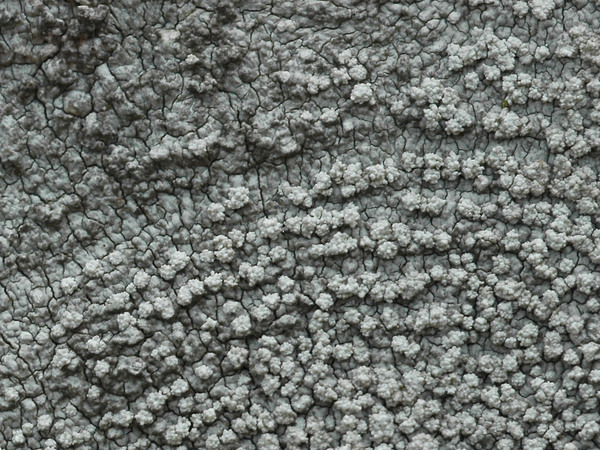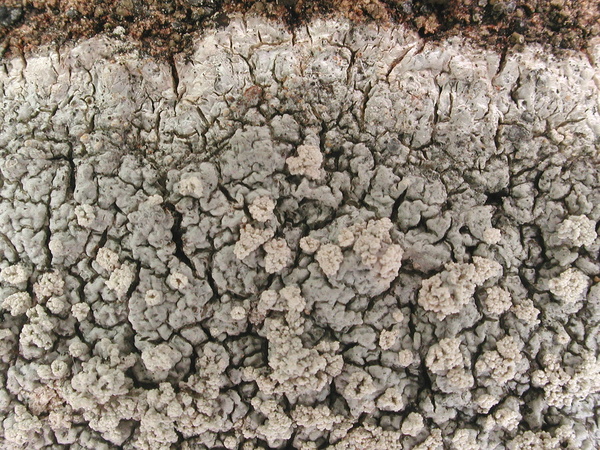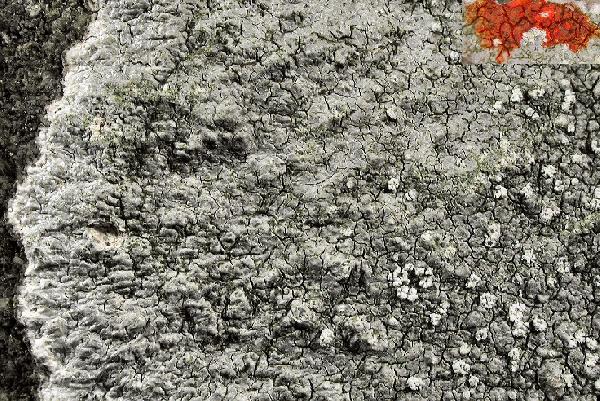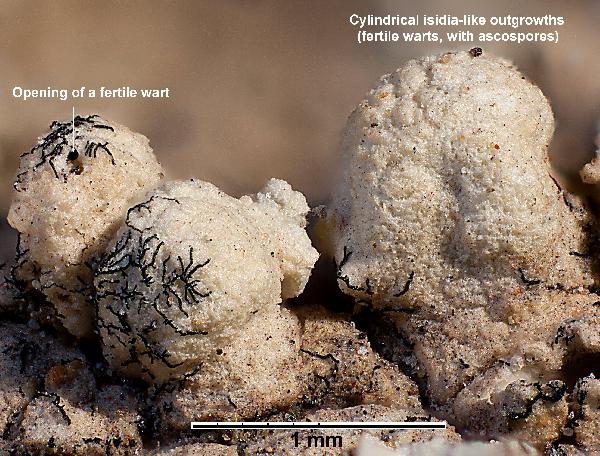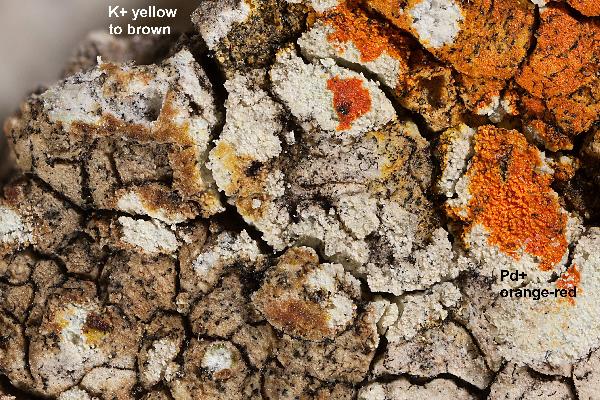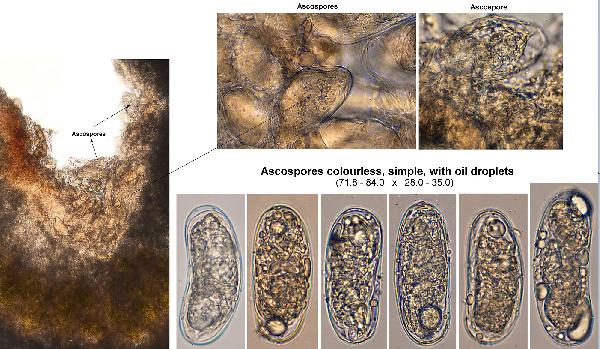Lepra aspergilla (Ach.) Hafellner
in Hafellner & Türk, Stapfia, 104: 171, 2016. Basionym: Variolaria aspergilla Ach. - Lichenogr. Suec. Prodr.: 28, 1799.
Synonyms: Marfloraea aspergilla (Ach.) S. Y. Kondr., L. Lőkös & J.-S. Hur; Pertusaria aspergilla (Ach.) J.R. Laundon; Pertusaria dealbata auct. non (Ach.) Cromb.; Pertusaria dealbescens auct. non Erichsen
Distribution: N - TAA, Lomb (Valcuvia & al. 2003, De Vita & Valcuvia 2004, Delucchi & Valcuvia 2004, Nascimbene 2006), Piem, VA (Piervittori & Isocrono 1999), Emil (Valcuvia & Delucchi 2001, Fariselli & al. 2020), Lig. C - Tosc, Umb (S-F127579), Laz, Sar (Nöske 2000, Nöske & al. 2000). S - Cal (Puntillo 1996), Si (Grillo & al. 1996, Grillo 1998, Grillo & Caniglia 2004, Iacolino & Ottonello 2006).
Description: Thallus crustose, episubstratic, rather thin, rimose-areolate, pale to dark grey, sometimes delimited by a thin prothalline line, sorediate. Soralia 0.3-1 mm across, at first punctiform, then maculiform and irregular in outline, finally often confluent, convex, whitish, with coarsely granular soredia; sparse cylindrical isidia-like outgrowths are sometimes also present. Apothecia and pycnidia unknown, but a sample from Macaronesia (La Gomera), identified by H. Sipman, was fertile, the spores measuring 71.8-84 x 28-35 µm (U. Kirschbaum, in litt.). Photobiont chlorococcoid. Spot tests: cortex/soralia K+ yellow turning yellow-brown, C-, KC+ pale yellow-orange, P+ orange to rust-red, UV-. Chemistry: fumarprotocetraric acid (major), succinprotocetraric acid (major) and variable amounts of protocetraric acid.Note: on steeply inclined surfaces of siliceous rocks, with optimum in the montane belt.
Growth form: Crustose
Substrata: rocks
Photobiont: green algae other than Trentepohlia
Reproductive strategy: mainly asexual, by soredia, or soredia-like structures (e.g. blastidia)
Most common in areas with a humid-warm climate (e.g. most of Tyrrenian Italy)
Commonnes-rarity: (info)
Alpine belt: very rare
Subalpine belt: rare
Oromediterranean belt: absent
Montane belt: rather rare
Submediterranean belt: extremely rare
Padanian area: absent
Humid submediterranean belt: rare
Humid mediterranean belt: very rare
Dry mediterranean belt: absent
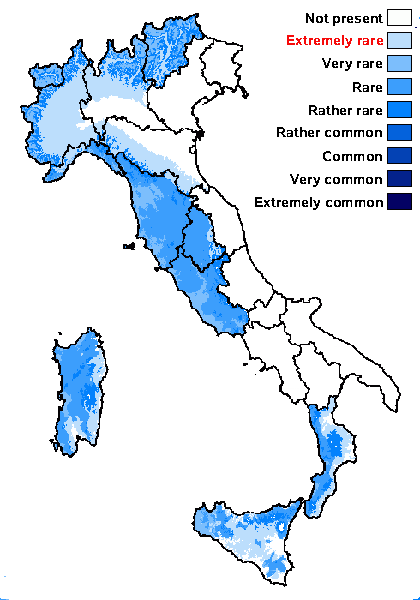
Predictive model
Herbarium samples
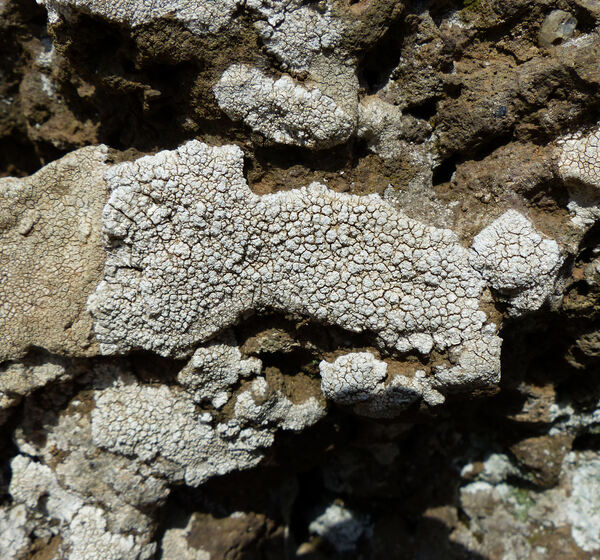

Andrea Moro; Owner: Department of Life Sciences, University of Trieste
Italy, Lazio, Roma, Ruines of ancient Tusculum, above Frascati
18/03/2017
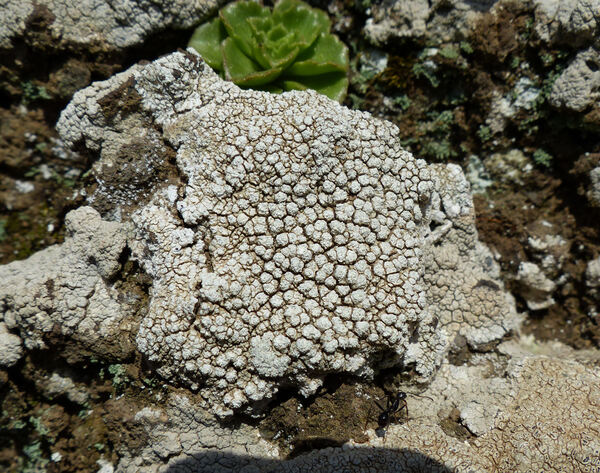

Andrea Moro; Owner: Department of Life Sciences, University of Trieste
Italy, Lazio, Roma, Ruines of ancient Tusculum, above Frascati
18/03/2017
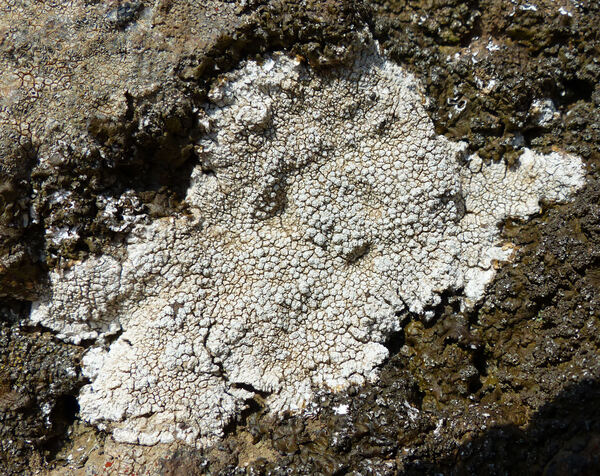

Andrea Moro; Owner: Department of Life Sciences, University of Trieste
Italy, Lazio, Roma, Ruines of ancient Tusculum, above Frascati
18/03/2017


Felix Schumm - CC BY-SA 4.0
[2845], Germany, Rheinland-Pfalz, Kreis Bad Kreuznach, Nahetal bei Kirn, nordexponierte Geröllhalde des Hellberges, auf Basalt/Melaphyr, ca. 250 m, TK 6210. Leg. Blaufuß 24.10.1977, det. F. Schumm, conf. V. Wirth 1981.
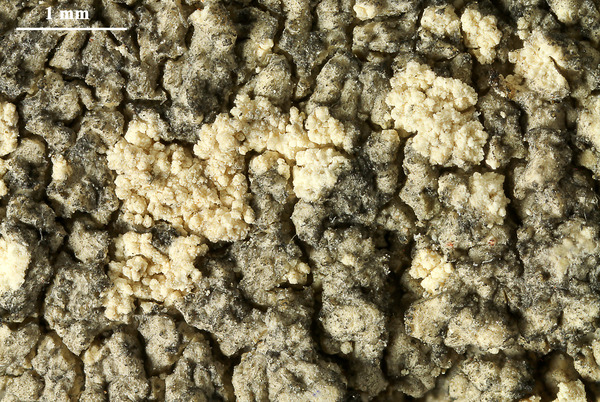

Felix Schumm - CC BY-SA 4.0
[2845], Germany, Rheinland-Pfalz, Kreis Bad Kreuznach, Nahetal bei Kirn, nordexponierte Geröllhalde des Hellberges, auf Basalt/Melaphyr, ca. 250 m, TK 6210. Leg. Blaufuß 24.10.1977, det. F. Schumm, conf. V. Wirth 1981.


Felix Schumm - CC BY-SA 4.0
[2845], Germany, Rheinland-Pfalz, Kreis Bad Kreuznach, Nahetal bei Kirn, nordexponierte Geröllhalde des Hellberges, auf Basalt/Melaphyr, ca. 250 m, TK 6210. Leg. Blaufuß 24.10.1977, det. F. Schumm, conf. V. Wirth 1981.
z: zeorin, f: fumarprotocetraric acid, protocetraric acid, conf. J.A. Elix
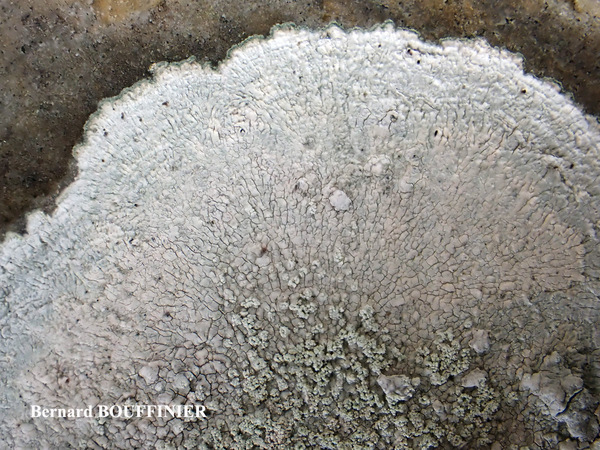
Bernard Bouffinier - Source: http://www.lichensmaritimes.org/index.php?task=fiche&lichen=302&lang=en
France, Cap de la Chèvre
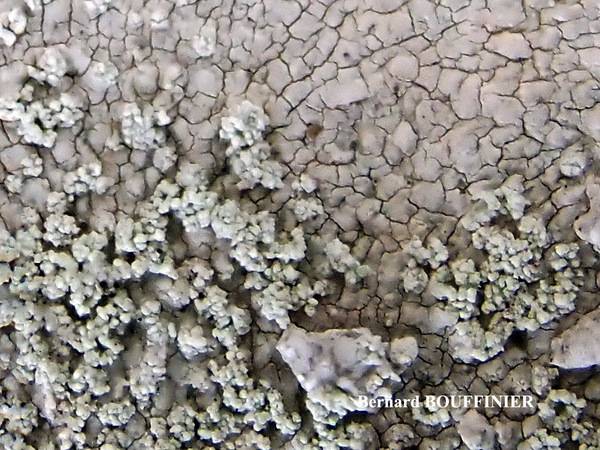
Bernard Bouffinier - Source: http://www.lichensmaritimes.org/index.php?task=fiche&lichen=302&lang=en
France, Cap de la Chèvre
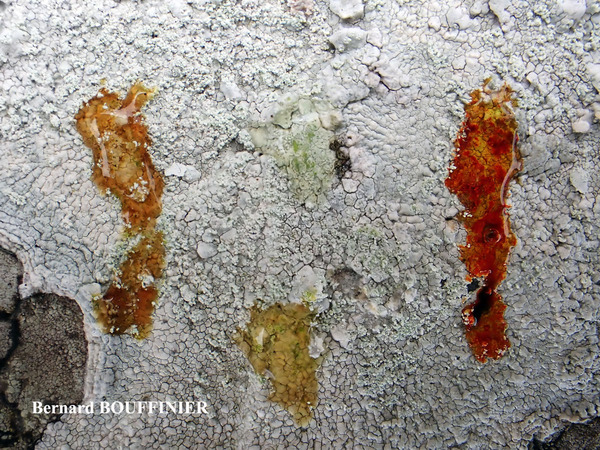
Bernard Bouffinier - Source: http://www.lichensmaritimes.org/index.php?task=fiche&lichen=302&lang=en
France, Cap de la Chèvre
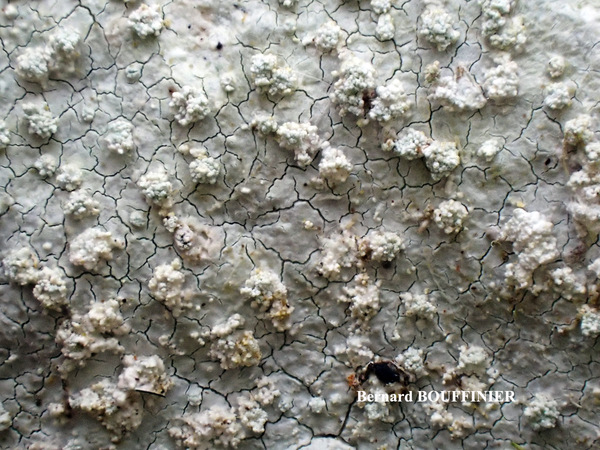
Bernard Bouffinier - Source: http://www.lichensmaritimes.org/index.php?task=fiche&lichen=302&lang=en
France, Argol
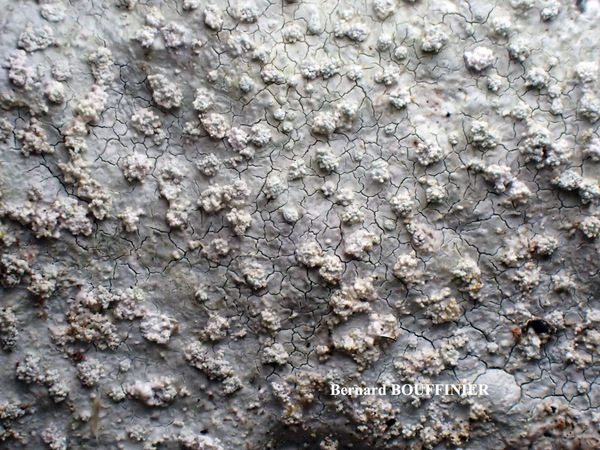
Bernard Bouffinier - Source: http://www.lichensmaritimes.org/index.php?task=fiche&lichen=302&lang=en
France, Argol

Bernard Bouffinier - Source: http://www.lichensmaritimes.org/index.php?task=fiche&lichen=302&lang=en
France, Argol
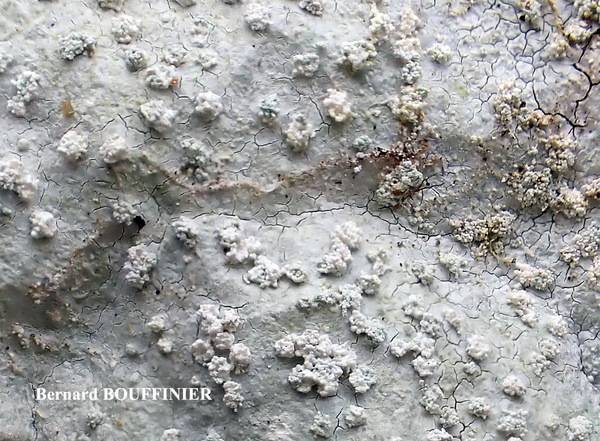
Bernard Bouffinier - Source: http://www.lichensmaritimes.org/index.php?task=fiche&lichen=302&lang=en
France, Argol

Bernard Bouffinier - Source: http://www.lichensmaritimes.org/index.php?task=fiche&lichen=302&lang=en
France, Argol
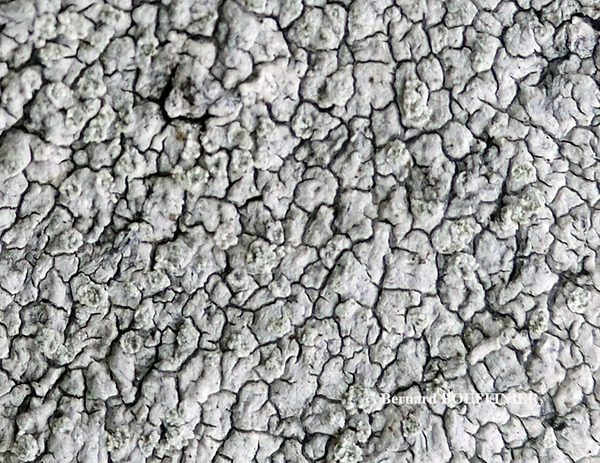
Bernard Bouffinier - Source: http://www.lichensmaritimes.org/index.php?task=fiche&lichen=302&lang=en
France, Commana
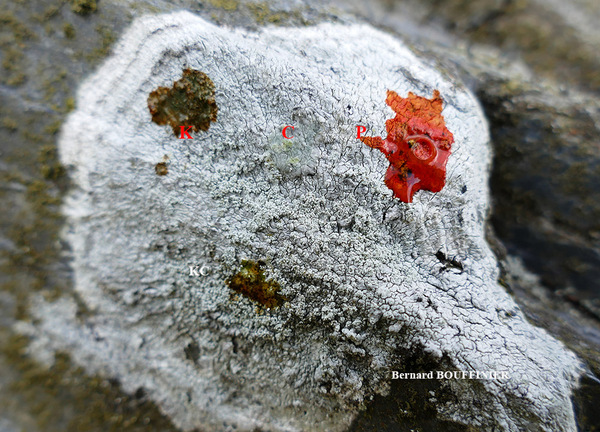
Bernard Bouffinier - Source: http://www.lichensmaritimes.org/index.php?task=fiche&lichen=302&lang=en
France, Commana
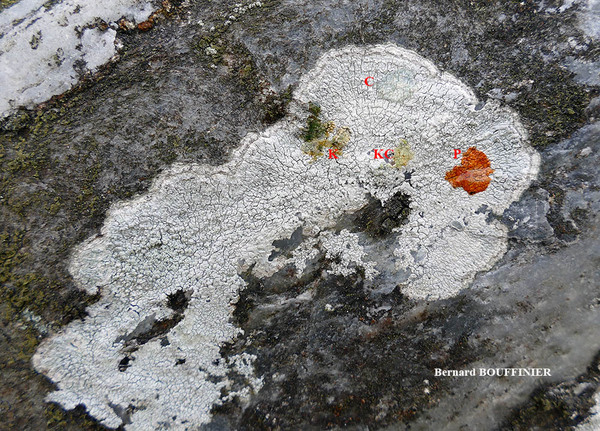
Bernard Bouffinier - Source: http://www.lichensmaritimes.org/index.php?task=fiche&lichen=302&lang=en
France, Commana
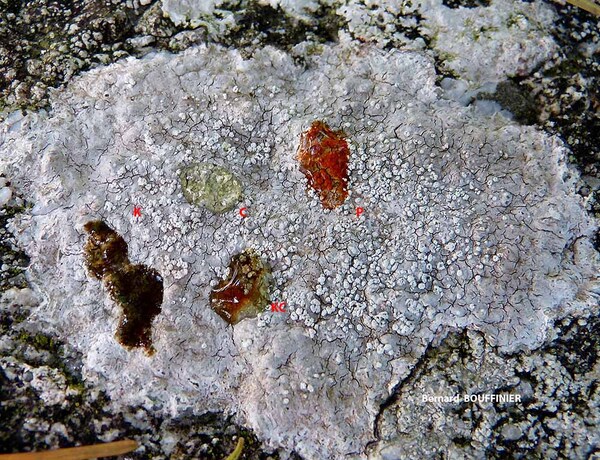
Bernard Bouffinier - Source: http://www.lichensmaritimes.org/index.php?task=fiche&lichen=302&lang=en
France, Saint-Herbot Sommet d'un parapet de pont
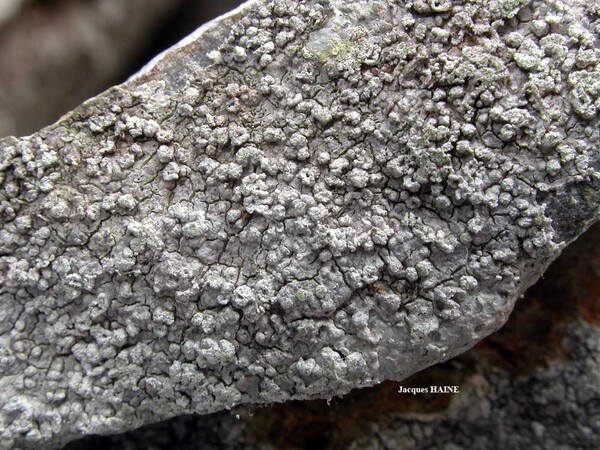
Jacques Haine - Source: http://www.lichensmaritimes.org/index.php?task=fiche&lichen=302&lang=en
France, Givet
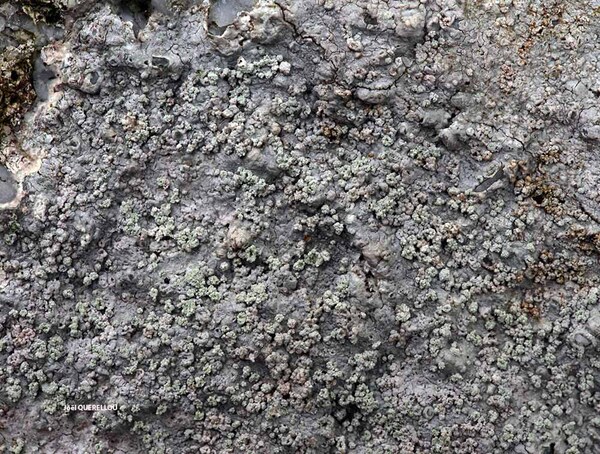
Joël Querellou - Source: http://www.lichensmaritimes.org/index.php?task=fiche&lichen=302&lang=en
France, Saint-Herbot Sommet d'un parapet de pont
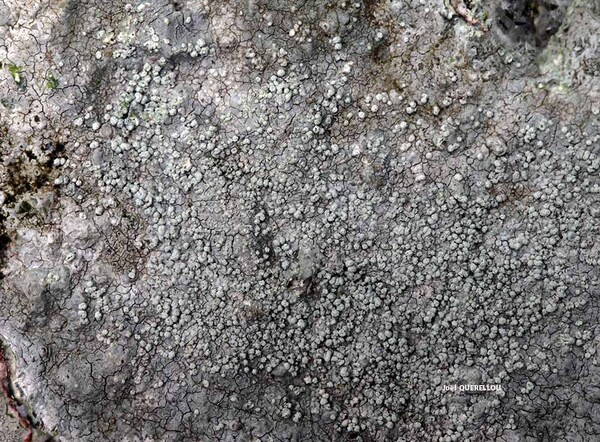
Joël Querellou - Source: http://www.lichensmaritimes.org/index.php?task=fiche&lichen=302&lang=en
France, Saint-Herbot Sommet d'un parapet de pont
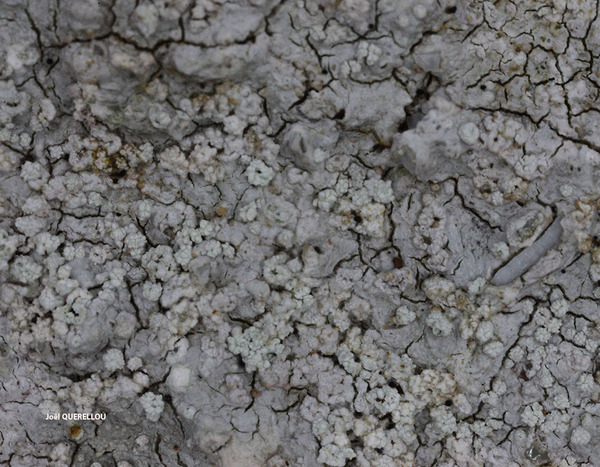
Joël Querellou - Source: http://www.lichensmaritimes.org/index.php?task=fiche&lichen=302&lang=en
France, Saint-Herbot Sommet d'un parapet de pont
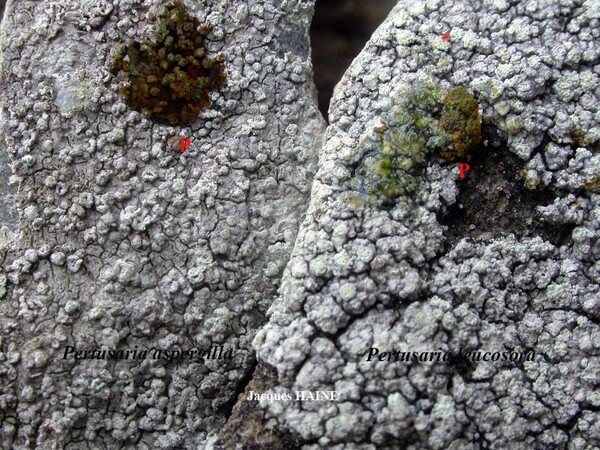
Jacques Haine - Source: http://www.lichensmaritimes.org/index.php?task=fiche&lichen=302&lang=en
France, Saint-Herbot Sommet d'un parapet de pont
Comparison between L. aspergilla and L. leucosora
Growth form: Crustose
Substrata: rocks
Photobiont: green algae other than Trentepohlia
Reproductive strategy: mainly asexual, by soredia, or soredia-like structures (e.g. blastidia)
Most common in areas with a humid-warm climate (e.g. most of Tyrrenian Italy)
Commonnes-rarity: (info)
Alpine belt: very rare
Subalpine belt: rare
Oromediterranean belt: absent
Montane belt: rather rare
Submediterranean belt: extremely rare
Padanian area: absent
Humid submediterranean belt: rare
Humid mediterranean belt: very rare
Dry mediterranean belt: absent

Predictive model
| Herbarium samples |


Andrea Moro; Owner: Department of Life Sciences, University of Trieste
Italy, Lazio, Roma, Ruines of ancient Tusculum, above Frascati
18/03/2017


Andrea Moro; Owner: Department of Life Sciences, University of Trieste
Italy, Lazio, Roma, Ruines of ancient Tusculum, above Frascati
18/03/2017


Andrea Moro; Owner: Department of Life Sciences, University of Trieste
Italy, Lazio, Roma, Ruines of ancient Tusculum, above Frascati
18/03/2017


Felix Schumm - CC BY-SA 4.0
[2845], Germany, Rheinland-Pfalz, Kreis Bad Kreuznach, Nahetal bei Kirn, nordexponierte Geröllhalde des Hellberges, auf Basalt/Melaphyr, ca. 250 m, TK 6210. Leg. Blaufuß 24.10.1977, det. F. Schumm, conf. V. Wirth 1981.


Felix Schumm - CC BY-SA 4.0
[2845], Germany, Rheinland-Pfalz, Kreis Bad Kreuznach, Nahetal bei Kirn, nordexponierte Geröllhalde des Hellberges, auf Basalt/Melaphyr, ca. 250 m, TK 6210. Leg. Blaufuß 24.10.1977, det. F. Schumm, conf. V. Wirth 1981.


Felix Schumm - CC BY-SA 4.0
[2845], Germany, Rheinland-Pfalz, Kreis Bad Kreuznach, Nahetal bei Kirn, nordexponierte Geröllhalde des Hellberges, auf Basalt/Melaphyr, ca. 250 m, TK 6210. Leg. Blaufuß 24.10.1977, det. F. Schumm, conf. V. Wirth 1981.
z: zeorin, f: fumarprotocetraric acid, protocetraric acid, conf. J.A. Elix

Bernard Bouffinier - Source: http://www.lichensmaritimes.org/index.php?task=fiche&lichen=302&lang=en
France, Cap de la Chèvre

Bernard Bouffinier - Source: http://www.lichensmaritimes.org/index.php?task=fiche&lichen=302&lang=en
France, Cap de la Chèvre

Bernard Bouffinier - Source: http://www.lichensmaritimes.org/index.php?task=fiche&lichen=302&lang=en
France, Cap de la Chèvre

Bernard Bouffinier - Source: http://www.lichensmaritimes.org/index.php?task=fiche&lichen=302&lang=en
France, Argol

Bernard Bouffinier - Source: http://www.lichensmaritimes.org/index.php?task=fiche&lichen=302&lang=en
France, Argol

Bernard Bouffinier - Source: http://www.lichensmaritimes.org/index.php?task=fiche&lichen=302&lang=en
France, Argol

Bernard Bouffinier - Source: http://www.lichensmaritimes.org/index.php?task=fiche&lichen=302&lang=en
France, Argol

Bernard Bouffinier - Source: http://www.lichensmaritimes.org/index.php?task=fiche&lichen=302&lang=en
France, Argol

Bernard Bouffinier - Source: http://www.lichensmaritimes.org/index.php?task=fiche&lichen=302&lang=en
France, Commana

Bernard Bouffinier - Source: http://www.lichensmaritimes.org/index.php?task=fiche&lichen=302&lang=en
France, Commana

Bernard Bouffinier - Source: http://www.lichensmaritimes.org/index.php?task=fiche&lichen=302&lang=en
France, Commana

Bernard Bouffinier - Source: http://www.lichensmaritimes.org/index.php?task=fiche&lichen=302&lang=en
France, Saint-Herbot Sommet d'un parapet de pont

Jacques Haine - Source: http://www.lichensmaritimes.org/index.php?task=fiche&lichen=302&lang=en
France, Givet

Joël Querellou - Source: http://www.lichensmaritimes.org/index.php?task=fiche&lichen=302&lang=en
France, Saint-Herbot Sommet d'un parapet de pont

Joël Querellou - Source: http://www.lichensmaritimes.org/index.php?task=fiche&lichen=302&lang=en
France, Saint-Herbot Sommet d'un parapet de pont

Joël Querellou - Source: http://www.lichensmaritimes.org/index.php?task=fiche&lichen=302&lang=en
France, Saint-Herbot Sommet d'un parapet de pont

 INDEX FUNGORUM
INDEX FUNGORUM
 GBIF
GBIF
 DOLICHENS
DOLICHENS

